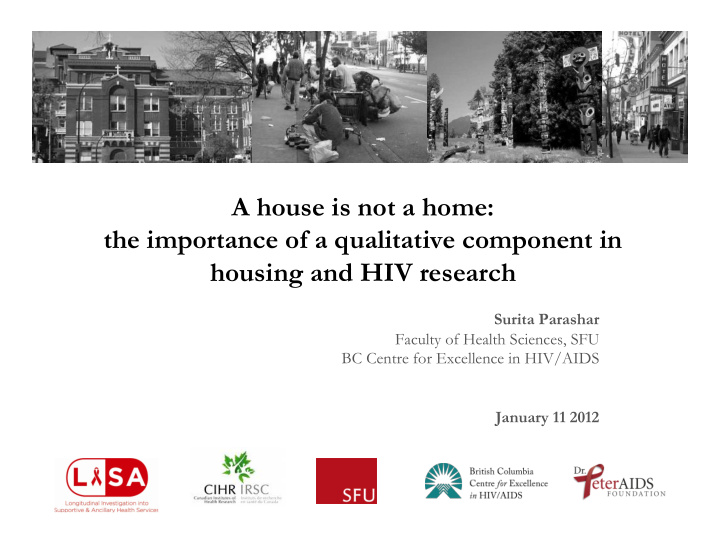



A house is not a home: the importance of a qualitative component in housing and HIV research Surita Parashar Faculty of Health Sciences, SFU BC Centre for Excellence in HIV/AIDS January 11 2012
Outline • Background: the LISA study • The way I see it project • The contributions of qualitative methods • Types of qualitative methods
Background: The LISA study • L ongitudinal I nvestigations into S upportive and A ncillary health services (LISA) project is a cross-sectional study of individuals on HAART in BC. • Participants were recruited through the Drug Treatment Program (DTP) at the BC Centre for Excellence in HIV/ AIDS (BC-CfE). • Clinically relevant socio-demographic factors were collected through an interviewer-administered survey and clinical variables were obtained through a longitudinal linkage with the DTP at the BC-CfE.
Background: the LISA study • From July 2007-January 2010, over 1,000 participants • Average age: 45 (40-51) • Women: 225 (25.5%) • Men who have sex with men: 282 (28.2%) • Food insecure: 684 (68.4%) • History of injection drug use: 601 (60.1%) • Unstably housed: 316 (31.6%)
Knowledge Translation and Exchange Measure of housing status • Unstable (living in a SRO, shelter, hostel, treatment centre, prison, or no fixed address at time of interview) vs. • Stable (living in an apartment or house).
Qualitative Research 101 • Qualitative research focuses on interpretation of phenomena in their natural settings to make sense in terms of the meanings people bring to these settings. Qualitative research involves collecting information about personal experiences, introspection, life story, interviews, observations, historical, interactions and visual text which are significant moments and meaningful in peoples’ lives. – Denzin and Lincoln 1994
Community Based Research Brings researchers together with members of the community
Community Based Research Equitably involves communities through all stages of research Meaningful Involvement of People living with HIV and AIDS in -Data collection -Data analysis -Data interpretation -Knowledge translation and exchange -Evaluating outcomes
Recruitment
Progress to date • 9 community researchers recruited and trained by peer facilitator. • 4 group sessions and 9 one-on-one sessions conducted • Over 300 photos taken • Qualitative analysis on going • Upcoming photo exhibit
Data Analysis and interpretation Photo Look for interviews : Review themes and Build Develop a transcripts hypotheses theory group and patterns in one on one the data
Knowledge Translation and exchange Photo exhibit inviting: -Researchers -Service providers -Community members -PHA and members of marginalized groups -Regional and provincial decision makers
!"#$%&'$($)##$*+,$ !"#$%&%'()#$*+",-#.%()/%0"%1"$%23*0'")04"$,).&$" )5%0'"#,%#.,".*6*0'"7*&$"89:"*0":)0+%26,(" Save the Date! March 1 st 2012 7:00pm – 9:00pm Reception, meet & greet with photographers and a discussion about the impact of housing on the health of people living with HIV W2 media café 250-111 West Hastings street
Why photovoice? Advantages: -Increased accessibility or ‘voice’ -Deeper, more meaningful engagement -Involves people who favour visual expression -An effective method of engaging with policymakers
Qualitative vs. Quantitative LISA study The Way I see it Goal Prediction, test Understand, meaning hypothesis Focus Quantity (prevalence of Quality (features of living unstable housing) conditions) Data Collection Questionnaire, scales Photos, interviews Research Design Structured, Flexible, emerging (!) predetermined Sample Large, random, Small, purposeful (9) representative (1000) Analysis Deductive (statistical Inductive (by the methods) research team) Role of Researcher Detached Immersed
Acknowledgements The Way I see it team: Lora Bellrose, Mel Hennan, Rosemina Jamal, Rob Lamoureaux, , Jennifer Mendozu, Randy Moors, Valerie Nicholson, Lyanna Storm, Lynda Swanson, Daniel Wilson. Community partners LISA project staff Simon Fraser University BC Centre for Excellence in HIV/AIDS staff Canadian Institutes of Health Research LISA participants
Recommend
More recommend